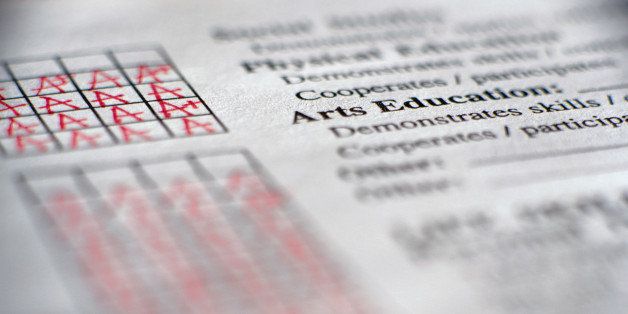
Recently, a parent in my community wrote about his delight in receiving a report card for his child on which the teacher actually wrote a few personal comments about his daughter. I remember receiving those kinds of reports cards when my children attended elementary school. Now all my grandkids receive are computer-generated cards with meaningless numbered comments.
I happened to see my granddaughter's report card that came home with her just before winter break. My daughter had glanced at the numbers to make sure there was nothing below "3" (meets grade level standards). Then she looked briefly at the standardized comments generated by the computer from what must be a long list. After telling her child she was proud of her, she put it aside in a pile of papers where I saw two weeks later.
At first glance, my granddaughter's report card did not seem that different from the ones I remembered from my children's era. Students received ratings in the same categories: Reading, Language Arts (combined in the new card), Math, Social Studies, Science, Fine Arts (separated into art, drama, and music on the new card), Physical Education, and "Homeroom" (still personal development and work/study habits). Within each category on the old-style report card, my kids could be rated between 1 (excellent) and 5 (needs improvement). On the 2015 version, there were 4 choices of "content standards," ranging from 4 (exceeds grade level standards) to 1 (not making satisfactory progress toward meeting grade level standards).
There was a major difference, however. All of my children's report cards were written by hand. As a parent, I skimmed over the array of letters and numbers. What really meant the most to me as a parent were those hand-written teacher comments:
"She is a good role model and is sensitive to others. It's fun to watch the confidence grow."
"A good aptitude for math and related concepts. Works well independently."
"I'm very pleased with her creative writing."
"She is well-liked by her peers as well as the adults who work with her."
"She contributes much to the overall tone of the room."
"Cursive writing will need more attention."
I had to include the last one as proof my daughter wasn't perfect. It also illustrates how much things have changed because my grandchildren no longer learn cursive writing.
I'm not naïve. As a former teacher and preschool director, I know my children's teachers had phrases they repeated from child to child when they wrote out those comments. Yet, I also know that asking teachers to write these comments and apply them to each individual student resulted in them seeing their students as unique little people.
Flash forward 30+ years. Ironically, my granddaughter goes to the same school her mother attended. But when I dug out her mother's report card for the same grade (I am an insane saver), what a difference. The report card "comments" my granddaughter received included: "97, 100, 30, and 25". I found the key on the back of the card that translated those numbers into meaningless, generic remarks.
(97) Respects classroom environment
(100) Has a positive attitude
(30) Reads extensively
(25) Grasps new ideas readily
Maybe it's the numbers. Maybe it's the absence of a human's handwriting. Maybe it's the fact that someone at a higher level (The school district? The State? A report card generating company?) created these comments. They are nice but relatively meaningless to the parent who reads them.
I suspect these report cards take even more of a teacher's time than the ones that allowed for personalized comments. Now we have computers, which enable teachers to say both more but ironically mean less on a child's report card. Judging from the numbered comments, there were over 100 options from which the poor teacher had to choose. It would have been faster and more meaningful to write a couple of sentences.
If you dig deeper, the new report card tells parents even less than the one I received for my kids. In many cases, there is no option for a child to receive anything higher than "3" (meets standards). For example, in second grade Mathematics, a child can't exceed standards in things like understanding place value, knowing basic addition and subtraction, or telling time. Since this is what they learn in that grade, and they are not exposed to anything more, if they can do these things they earn a "3." Same thing is true of Science where students are only expected to develop questions, collect data, record their work, and communicate results to others. If a child does these things, that's a "3." How would a parent know if her child were particularly strong in math or science given the criteria listed under these subjects?
Perhaps this type of report card is just a reflection of where we are as a society regarding education. Standards show the parent what the typical elementary student needs to know at a given grade level, and that is important. Along with these grade level expectations and standardized comments, however, there is no opportunity to indicate anything personal about a child.
Most parents would agree that "3" doesn't tell them what they want to know. Does their child work really hard to get those "3's" or could he be challenged even more? More importantly, does the teacher see what is unique and special about their child? A couple of brief comments that show parents their children are valued and understood for who they really are matter far more than a bunch of numbers.
I invite you to join my Facebook community and subscribe to my newsletter.
